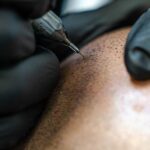Facelift surgeries vary based on the desired results. Traditionally, while carrying out the procedure, the surgeon makes an incision in the hairline close to the temples. This incision is made in front of the ears, down in the front and hugging the lobe of the ear, then goes back to the lower scalp at the back of the ears.
Excess skin and fat may be redistributed or removed from the face. The connective tissue and underlying muscle are redistributed and tightened. In the event that there is minimal sagging of the skin, a mini facelift procedure may be carried out; shorter incisions are used in this procedure.
If a neck lift will be carried out as well, the fat and excess skin will be taken off. The skin on the neck will be pulled up, tightened and pulled back. This is frequently done by making an incision right under the chin.
Typically, the incisions have skin glue or dissolvable sutures. In certain cases, you may need to go back to the surgeon to have the stitches taken off. These incisions are done in such a manner that they blend in with your facial structure and hairline. Normally, the individual will have bandages wrapping his or her face and a surgical drainage tube.
Risks and Side Effects
Risks are there to any medical procedure and facelifts are not excluded. These risks could include:
• Cardiac events
• Anesthesia risks
• Bleeding
• Infection
• Scarring or pain
• Blood clots
• Prolonged swelling
• Hair loss at the incision points
• Problems with healing of the wound
Have a discussion with your doctor regarding all of the risks involved with a facelift surgery to ensure that the procedure is best for you.
Expectations Following a Facelift
Following the surgery, the physician will possibly prescribe pain medication. There may or may not be some discomfort or pain along with bruising and swelling; this is all normal. The surgeon will provide you with instructions on when to take off any drains or dressings and when to come in for a follow-up appointment.
When the swelling subsides, the difference in appearance will be obvious. When it comes to the skin feeling normal again, this typically takes a number of months. You should give it about two weeks before a usual level of daily activity is resumed. As it relates to exercise and other strenuous activity, a wait of approximately four weeks is usually recommended. However, each person is different, so the doctor will provide advice on when your usual activities can be resumed.
To help in extending the outcome of your facelift, daily moisturize your face, safeguard it against the sun and strive to live a healthy lifestyle. The outcomes of a facelift are not guaranteed; the desired result might not be achieved from a single surgery and sometimes a follow-up surgery is required. Have a discussion with the surgeon about what can be done to help in ensuring a successful facelift and what can be reasonably expected from the surgery.
Looking to have a facelift done? Visit here first!








